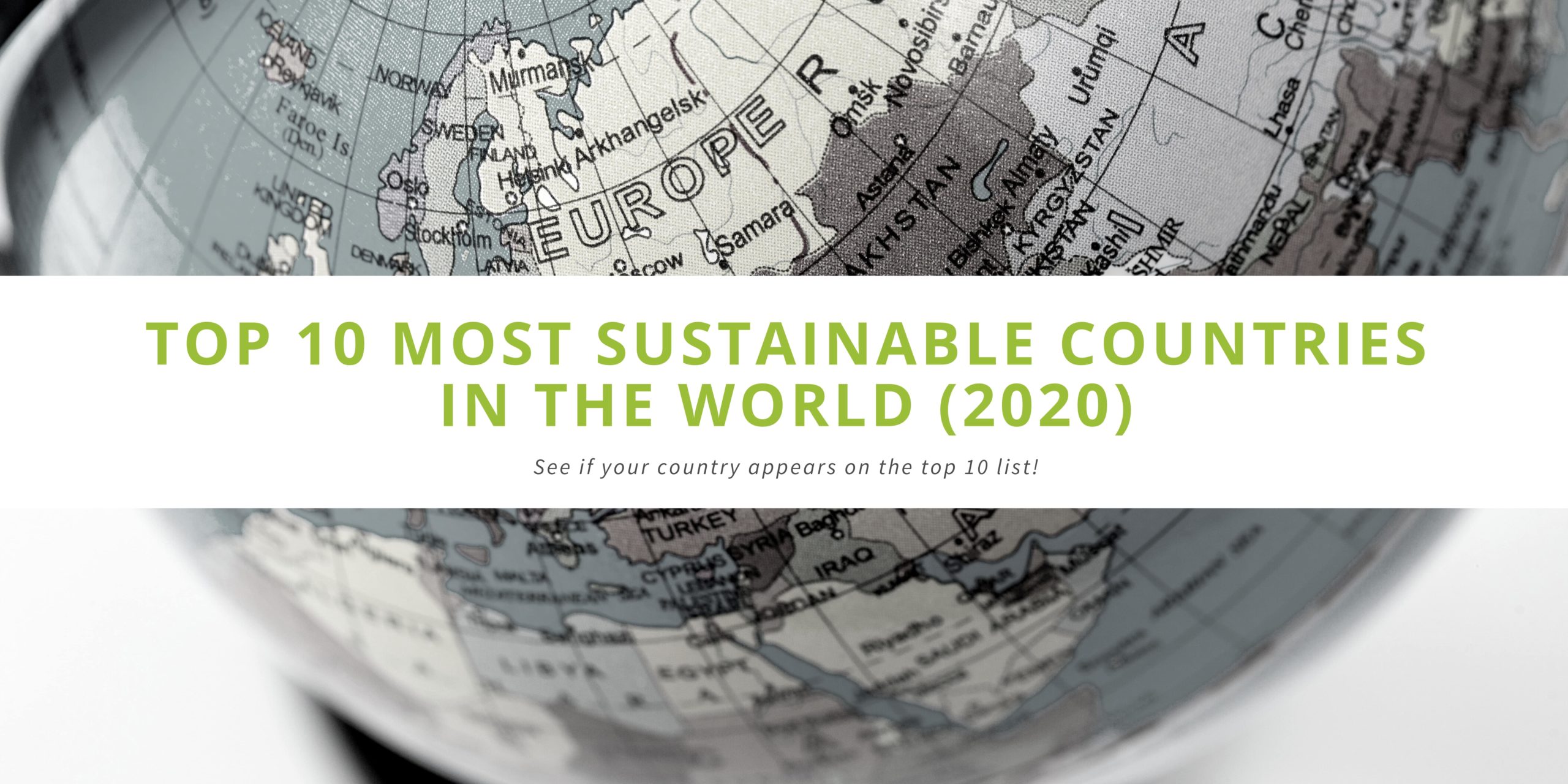
Top 10 Most Sustainable Countries in the World (2020)
Is your country on the top 10 list? Read on to find out where they ranked and what they are doing to combat climate change.
Read time: 7 minutes
What is sustainability?
Sustainability has been defined in many ways, but most famously as: ‘meeting the needs of the present without compromising the ability of future generations to meet their own needs’ (Brundtland Commission, 1987). First appearing in the United Nations (UN) report in 1987, the concept of sustainability surprisingly dates back to 1798, when Thomas Malthus observed that the population tends to grow quicker than resources. This is still true today! Every new person is a new consumer, adding to that demand. Today 7.8 billion people are using more of the Earth’s resources than it can regenerate.
There is no denying that the Earth’s resources won’t last forever. With humankind depending on non-renewable fuels for about 80% of the world’s energy, the time will come when these finite sources will run out. This is why sustainability is so important, because from 1970 to 2010 our natural resource consumption has more than tripled. Our overconsumption and extraction of materials, fuels and food have contributed to half of the total global greenhouse gas (GHG) emissions since the 1970s. Such man-made pollution has contributed to global warming, ocean acidification, desertification and changing climate patterns. Continuous exploitation of natural resources and environmental degradation will lead to severe, irreversible changes for people, economies and ecosystems around the world.
The Environmental Performance Index (EPI) measures the performance of each country’s sustainable targets. The EPI offers a scoreboard that highlights leaders and laggards, using 32 performance indicators across 11 issue categories. The top ranked countries are those who are best addressing the environmental challenges that every nation faces.
A global problem requires a global solution, and when it comes to protecting the environment for future generations, some countries are doing more than others.
Top 10 Sustainable Countries:
1. Denmark
Taking first place is Denmark with an EPI score of 82.5. Since 1990, Denmark has reduced its GHG emissions from energy consumption by 33% and aims to further reduce them by 40% by 2020.
In 2019, for the first time ever, half of the country’s electricity consumption originated from renewable generation! With 47% of the green energy coming from wind turbines and the rest from solar. The Horns Rev 3 offshore wind farm of 407MW can cover the annual electricity consumption of about 425,000 households by itself. Along with Denmark’s world-class green energy system, the country has just passed a climate law set to reduce GHG emissions by 70% in 2030 against the 1990 benchmark, and ultimately reach net zero in 2050.
Samso Island, famous for its potatoes, has been 100% sustainable since 2007, relying entirely on renewable energy such as wind, solar, and biomass energy.
Credit: Energy Live News
2. Luxembourg
In second place is Luxembourg with an EPI score of 82.3. Becoming the first European country to launch a Sustainability Bond Framework. This framework will reinforce Luxembourg’s commitment to sustainability and to support its efforts and ambitions, whilst providing national and international investors the opportunity to diversify their investments with more sustainable assets.
Credit: World Footprints
3. Switzerland
Switzerland is increasingly known for its stance on sustainable development and preserving the environment, scoring 81.5 on the Environmental Performance Index. It’s one of the few countries that does not send any urban waste to landfill. Instead, 50% is recycled and the rest is used to produce energy.
Zurich is one of the three most sustainable cities in the world. The city has been praised for its dedication to improving the environment, with 82% of its electricity coming from renewable energies.
Thanks to the growing popularity of solar panels, solar energy production has quadrupled in 5 years, with 80% being installed on residential buildings.
Credit: Lonley Planet
4. United Kingdom
The United Kingdom is considered to be the 4th greenest country in the world according to its EPI score of 81.3. In 2018, the UK invested £60 million to develop packaging which will reduce the impact harmful plastics are having on the environment. Meanwhile, a plastic straw ban came into play in England on 1st October 2020, not long after the 2018 plastic microbeads ban, and the 5p plastic bag charge introduced in 2015.
The UK government has introduced a Green Homes Grant scheme which gives homeowners in England up to £5,000 to help make green home improvements.
The Prime Minister Boris Johnson released his long-awaited ten-point plan for a green industrial revolution, on Tuesday 18th November. The blueprint aims to boost green investments and create 250,000 jobs to support the country’s former industrial heartland. The plan aims to mark ‘the beginning of the UK’s path to net zero’, by focusing on clean energy, electric vehicles, greener buildings and transforming public transport. You can read about what Boris has planned for the UK in his ten-point plan here.
Credit: Earth Times
5. France
France has long been committed to protecting the planet with environment-friendly practices, home to the famous Paris Climate Agreement.
Four hydrokinetic turbines are situated in the River Rhône, making the farm the first of its kind in the world. Over the next 18 years, it will produce one gigawatt-hour of renewable electricity per year – that’s enough to power 400 homes and reduce CO2 emissions by 300 tonnes per year!
The capital city of Paris plans to reduce transport GHG emissions in the inner city by 60% by 2020 and double their biking lanes to make the city more bike friendly.
EPI: 80
Credit: Business Green
6. Austria
Austria is home to one of the largest “green tech” clusters, where more than 200 companies are developing green technologies and services. In a country where 60% of electricity generation comes from hydroelectric plants, Austria is a European leader in green energy technologies.
The country has banned oil boilers from newly-built houses and apartments, an important step towards the reduction of greenhouse gases.
EPI: 79.6
Credit: Lonely Planet.
7. Finland
Finland has set an ambitious plan to be carbon neutral by 2035. The country also has the cleanest air in the world, and this is due to five reasons.
Firstly, there’s no pollutants. There’s less than six micrograms per cubic metre, the lowest level on the globe. Secondly, there’s no industrial waste. Finland has limited the use of coal-fired power plants, transportation, deforestation and waste burning; reducing their air pollution. Thirdly, Finland’s low population density has contributed to their unspoilt natural environment. Fourthly, it has the 11th largest green cover in the world, contributing to its clean air. Finally, their government invests in renewable energy as it plans to phase out the use of coal for energy.
EPI: 78.9
Credit: Good News Finland
8. Sweden
Sweden has continually ranked as one of the most sustainable countries in the world. Stockholm’s Central Station is partly heated using the body heat of the 250,000 commuters who pass through the station every day.
Waste from the local forest industry is burned to generate heat and power. As a result, 90% of energy used in the city for heating and electricity comes from trees!
EPI: 78.7
Credit: NBC News
9. Norway
Norway has been leading the way for renewable energy. Currently 97% of Norway’s energy comes from hydropower, home to the largest hydropower nation in Europe.
Leading the way for putting more electric vehicles on the road, electric cars accounted for 61.5% of cars registered in September of 2020 alone.
EPI: 77.7
Credit: Trade Forum
10. Germany
Ending the list for top 10 sustainable countries is Germany. Set to close the last of their nuclear power plants by 2022, power production will be filled by renewables, gas turbines and conservation. Germany’s energy transformation, more widely known as ‘Energiewende’ aims to reduce CO₂ emissions and see the country transition to a more sustainable lifestyle. They’ve set an ambitious goal of generating 80% of the country’s power from renewables by 2050, investing €400 million to fund energy storage projects.
EPI: 77.2
Credit: Northwestern
Conclusion
Besides from practicing and implementing sustainable policies, a more common shared connection is being part of the Paris Agreement. This has put pressure on countries to make changes to reduce their CO₂ emissions and limit global temperatures – and it seems to be working! However, there is still a long way to go if we are to meet the target of limiting global temperature rising to 1.5°C. There is no doubt that countries across the globe are putting effort into becoming more sustainable, and trying to make a better future for future generations to come. Nonetheless, there will always be a need to find new ways of living sustainably for our future economy, society and environment.
You can learn more about where your country was ranked here.










